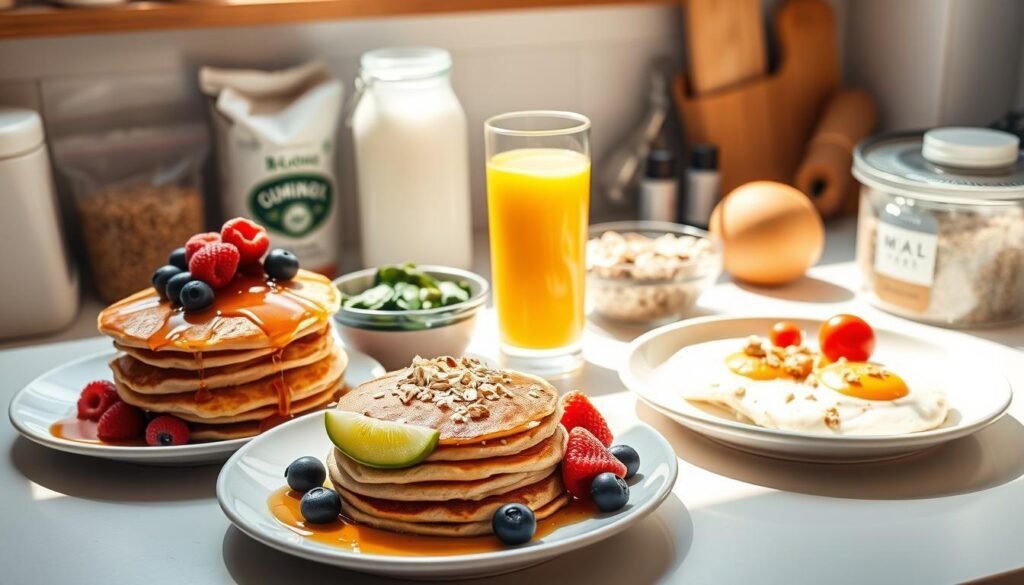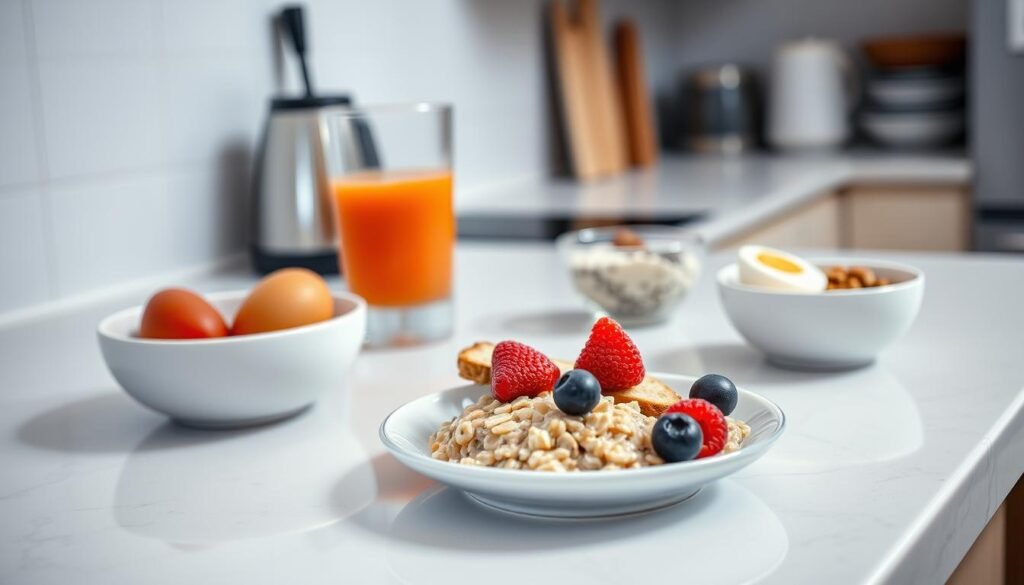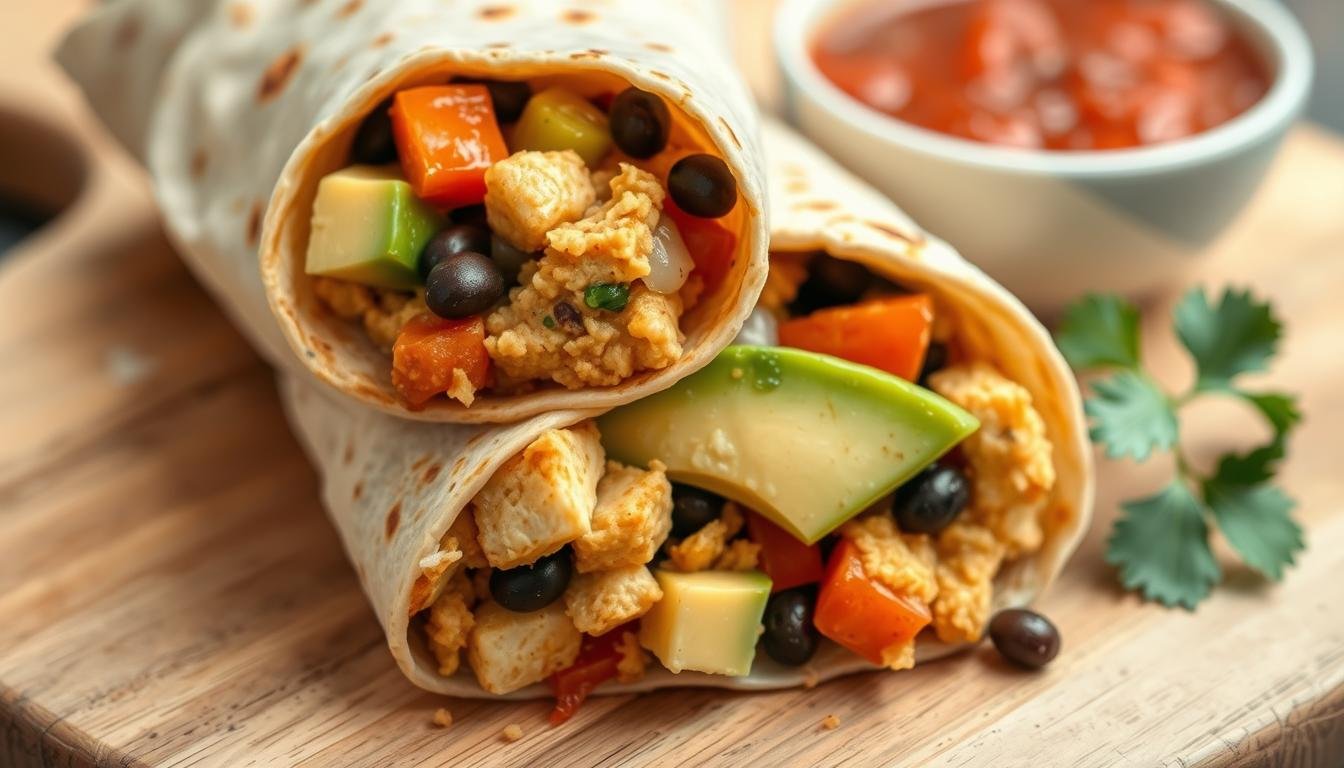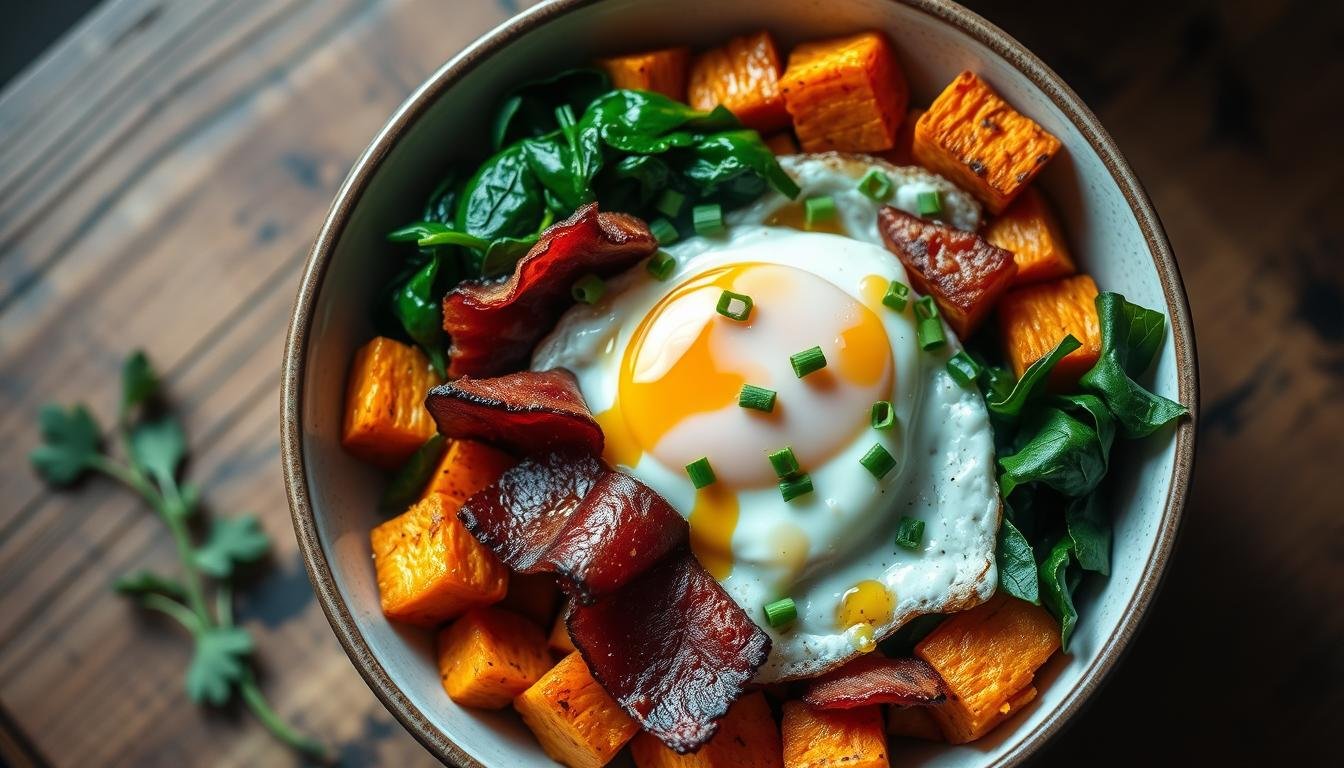You wake up with a sensitive stomach. You dread the first meal of the day. Even “healthy” foods feel like a gamble.
Sound familiar? I know how exhausting it can be. Every choice feels like a trigger. One wrong ingredient can ruin your day.
But here’s the good news: you don’t have to settle for bland or repetitive meals. With a little strategy, mornings can be nourishing, not stressful. This guide focuses on low-FODMAP swaps, gentle ingredients, and creative combination of 10 breakfast ideas for IBS sufferers.
These options support symptom management. They keep your taste buds engaged. Whether you’re avoiding high-FODMAP fruits, skipping caffeine, or steering clear of greasy staples, we’ve got you covered.
Key Notes;
- Identify common IBS triggers like certain fruits, dairy, or fatty foods to avoid morning discomfort.
- Use low-FODMAP alternatives (e.g., lactose-free yogurt or spinach) to create balanced meals.
- Plan ahead with simple recipes that minimize prep time and maximize digestive ease.
- Focus on hydration and fiber-rich, non-irritating ingredients to start your day gently.
- Experiment with warm spices like turmeric or ginger for added anti-inflammatory benefits.
Understanding IBS Triggers in Morning Meals
Starting your day with IBS-friendly foods is important. Knowing which foods activate symptoms is important. Many breakfast foods have hidden triggers that upset digestion. Let’s find out how to spot these foods and make better choices for a good morning.
Common Breakfast Culprits to Avoid
Many American breakfasts have foods that are bad for IBS:
- Wheat-based items: Bagels, muffins, and cereals with added inulin
- Aromatic vegetables: Onions in omelets or garlic in breakfast potatoes
- High-lactose dairy: Yogurt parfaits, creamy coffee drinks
| Breakfast Item | Problematic Component | IBS Reaction |
|---|---|---|
| Granola with Honey | Excess fructose | Bloating, cramping |
| Sausage & Egg Sandwich | High saturated fat | Delayed gastric emptying |
| Orange Juice | Sorbitol content | Diarrhea triggers |
Smart Ingredient Swaps
Try these good-for-your-gut alternatives from Medical News Today’s research:
- Bread: Sourdough (fermented to reduce FODMAPs)
- Flavor boosters: Garlic-infused oil instead of raw cloves
- Dairy substitutes: Lactose-free yogurt with raspberries
| Trigger Food | IBS-Friendly Swap | Benefit |
|---|---|---|
| Wheat Toast | Gluten-Free Oat Bread | Reduces fructans |
| Cow’s Milk | Almond Milk (unsweetened) | Low lactose content |
| Apple Slices | Cantaloupe Cubes | Lower fructose levels |
Using infused oils keeps flavors good without upsetting your stomach. For coffee fans, cold brew is lower in acidity than hot-brewed coffee. This simple switch can make mornings easier.
10 Breakfast Ideas for IBS Sufferers

Starting your day with meals that respect your digestive system doesn’t mean sacrificing flavor or variety. I’ve curated these breakfast solutions for IBS management. They focus on low-FODMAP ingredients and gut-friendly prep methods. Let’s explore recipes that turn morning meals into opportunities for nourishment.
Low-FODMAP Smoothies
Smoothies become IBS-safe when you swap high-FODMAP fruits for spinach, blueberries, and lactose-free yogurt. My go-to recipe adapts BBC’s berry smoothie concept:
- 1 cup fresh spinach
- ½ cup frozen blueberries
- ¾ cup lactose-free Greek yogurt
- 1 tbsp chia seeds
- Almond milk (to desired thickness)
Blend until smooth – the chia seeds add soluble fiber without triggering symptoms. For extra protein, I sometimes add a scoop of low-FODMAP certified vanilla protein powder.
Gentle Grain-Based Options
Oats are a triple threat: soluble fiber-rich, low-FODMAP in small servings, and endlessly customizable. Dietetic Directions’ peanut butter banana oatmeal gets my IBS-friendly makeover:
“Use ½ cup oats cooked in water, then stir in 1 tbsp peanut butter and ¼ sliced ripe banana. Top with cinnamon for flavor without FODMAP overload.”
For those sensitive to oats, try quinoa porridge with maple syrup and toasted coconut. Always measure grains – even safe foods can become triggers in large portions.
Egg-Centric Preparations
Eggs provide high-quality protein without FODMAPs. My favorite scramble combines:
- 2 eggs whisked with a pinch of turmeric
- ½ cup chopped bell peppers (green tip only)
- Handful of spinach
- 1 oz feta cheese (if tolerated)
Cook in olive oil over medium heat. Pair with sourdough toast (naturally lower in fructans) for a complete meal. Those with egg sensitivities can substitute firm tofu using the same method.
Make-Ahead Solutions
Batch cooking transformed my IBS mornings. Fun Without FODMAPs’ muffin blueprint works beautifully:
- Mix 2 cups gluten-free flour with 1 tsp baking soda
- Add 2 eggs, ½ cup maple syrup, and ¾ cup lactose-free milk
- Fold in 1 cup low-FODMAP fruit (strawberries, oranges)
- Bake at 350°F for 18-20 minutes
Freeze muffins individually – they reheat in 90 seconds. For savory options, try egg bites baked in muffin tins with safe veggies and cheese alternatives.
Meal Prep Strategies for IBS Management
Getting ready for breakfast is easier with IBS when you plan ahead. I’ve learned that making breakfasts early saves time and keeps away foods that upset my stomach. Here are some tips to make your mornings smoother and your meals easier on your stomach.
Batch Cooking Essentials
Freezing meals in single portions has changed my life with IBS. Ignite Nutrition’s frittata recipe is great for quick breakfasts. It freezes well in silicone muffin tins. For proteins like salmon fishcakes, Medical News Today recommends compartmentalized storage to avoid mixing foods.
Here are three things I always freeze:
- Overnight oats in mason jars (use lactose-free milk)
- Pre-portioned smoothie kits with low-FODMAP fruits
- Rice cake “sandwiches” with sunflower seed butter
Weekly Planning Tips
Spending time on Sunday mornings saves me a lot of time during the week. Dietetic Directions’ trick with wax paper makes pancakes easy to freeze. My tips for success include:
- Use separate cutting boards for foods that are high in FODMAPs
- Label containers with dates and what’s inside
- Prepare three main ingredients (quinoa, hard-boiled eggs, roasted carrots)
I use a magnetic whiteboard on my fridge to keep track of what I’ve prepped. Color-coded stickers help my family know what’s safe for IBS. Storing food right is key to avoiding bad days.
Building a Gut-Friendly Nutritional Profile

Starting with meals that help your gut is key. For those with IBS, it’s all about the right mix of nutrients. Soluble fiber and protein are the heart of a good breakfast.
Soluble Fiber Focus
The American College of Gastroenterology says 5-10 grams of soluble fiber a day helps with IBS. Oatmeal is great because it has 4 grams of this fiber. It helps soak up water in your stomach.
Chia seeds are a superfood with 10 grams of fiber and 5 grams of protein. Try the BBC’s chia pudding recipe:
- Mix 3 tbsp chia seeds with lactose-free milk
- Add low-FODMAP fruits like strawberries
- Let sit overnight for the best texture
Protein Pairing Principles
Combining lean proteins with fiber is smart. It makes digestion slower and keeps blood sugar steady. Eggs are full of amino acids, while plant-based foods add more fiber.
| Protein Source | Benefits | Serving Idea |
|---|---|---|
| Turkey sausage | Low-fat, high iron | With roasted sweet potatoes |
| Tofu scramble | Fiber-rich, vegan | Medical News Today’s turmeric-spiced recipe |
I mix proteins with soluble fiber like eggs and spinach. Or almond butter on oat crackers. This keeps my digestion smooth all morning.
Avoiding Common Breakfast Pitfalls

Creating digestion-friendly morning meals means looking beyond surface-level choices. Even foods marketed as “healthy” can trigger IBS symptoms through hidden FODMAPs or oversized portions. Let’s explore how to sidestep these traps using evidence-based strategies.
Hidden FODMAP Dangers
Many breakfast staples contain sneaky high-FODMAP ingredients. Cruciferous vegetables like broccoli and kale – often added to smoothies – become problematic in quantities over ¾ cup. Medical News Today highlights how sweet potatoes shift from low to moderate FODMAP when roasted versus boiled.
- Avoid “low-FODMAP” labels without portion context
- Recheck serving sizes using the Monash University app
- Watch for cumulative FODMAPs in multi-ingredient dishes
Portion Control Strategies
Dietetic Directions’ research shows even safe foods cause issues in large amounts. Their muffin study found symptoms spiked when servings exceeded 85g. Practical solutions:
- Use kitchen scales for grains like oats (max ½ cup cooked)
- Pre-portion nuts into 10-15g packets
- Follow Monash University’s “green light” serving sizes
Remember: digestion-friendly morning meals require both smart ingredient selection and mindful quantities. Track your responses for 3-4 days to identify personal thresholds.
Customizing Recipes for Your Needs
Finding the right irritable bowel syndrome breakfast recipes is all about making them yours. What helps one person might not work for another. That’s why trying different foods is key to feeling better.
Elimination Diet Basics
Begin with a 2-6 week diet where you avoid common foods. These include:
- High-FODMAP fruits
- Dairy products
- Gluten-containing grains
Stick to safe foods like rice cereal and lactose-free yogurt. Always work with a dietitian to keep your diet balanced.
Gradual Reintroduction Process
Once you’ve avoided certain foods, try A Little Bit Yummy’s 3-step plan:
| Phase | Duration | Action |
|---|---|---|
| Testing | 3-5 days per food | Introduce one ingredient at a time |
| Tracking | Entire process | Record symptoms in a food journal |
| Personalizing | Ongoing | Build permanent meal plans |
Medical News Today says start with small amounts when adding foods back. If eggs were a problem, start with just a quarter. This way, you can see how your body reacts without feeling overwhelmed.
Essential Kitchen Tools for IBS Cooking
Starting your day with IBS-friendly breakfasts is easier with the right tools. I’ve learned that choosing the right appliances makes cooking low-FODMAP foods simple. It keeps the taste and texture just right. Let’s look at three tools that make breakfast prep a breeze.
Must-Have Appliances
Spiralizers turn veggies into “zoodles” that are good for your gut. They replace foods that can upset your stomach. Spiralized zucchini is great in quick breakfast stir-fries, says the BBC.
High-speed blenders are key for smoothies that are low in FODMAPs. I use mine every day to mix lactose-free yogurt with fruits like strawberries. It blends well without adding air that can make you feel bloated.
Non-stick pans with ceramic coatings help cook eggs with little oil. This avoids the “fried food effect” that some with IBS feel. Choose pans with rounded edges for easy scrambling and flipping.
| Tool | Key Benefit | Ideal For |
|---|---|---|
| Spiralizer | Low-FODMAP veggie prep | Zucchini noodles |
| Blender | Smooth texture creation | Digestible smoothies |
| Non-Stick Pan | Oil-free cooking | Gentle egg dishes |
“The right tools don’t just save time – they create safer textures for sensitive digestive systems.”
Success Stories: Real-Life IBS Transformations
Discovering healthy breakfast choices for sensitive stomachs can change your mornings. Sarah Thompson, a 35-year-old graphic designer, cut her bloating by 80% in six weeks. She made small meal changes for lasting relief.
Morning Routine Makeovers
Sarah’s big change was switching from sugary cereals to BBC Good Food’s overnight oats. She used lactose-free yogurt and low-FODMAP berries. “My energy stayed up – no more 10 AM crashes,” she says.
Now, she eats:
- Chia pudding with almond milk
- Scrambled eggs with spinach
- Gluten-free toast with peanut butter
“Tracking my symptoms in a food diary showed patterns I never saw. Now, I meal prep every Sunday – it’s my self-care ritual.”
Sarah Thompson, Dietetic Directions client
Sustainable Habit Building
Medical News Today’s habit-stacking helped Sarah keep going. She added new recipes to her daily routines:
| Old Habit | New Stack | Result |
|---|---|---|
| Morning coffee | + 10-minute meal prep | Consistent breakfasts |
| Phone scrolling | + Grocery list update | Better ingredient control |
| Weekend Netflix | + Recipe research | Expanded safe foods list |
Sarah’s story shows lasting IBS management comes from flexible systems, not being perfect. Her next step? Teaching about gut-friendly eating at work.
Conclusion
Looking for good breakfasts that help your gut is easier with the 80/20 rule. Eat foods good for your gut 80% of the time. This lets you enjoy other foods too.
Try foods like low-FODMAP chia pudding or scrambled eggs with spinach. They help with different symptoms.
Keep track of how foods make you feel with a food journal or apps like MyFitnessPal. Start with simple recipes and add more as you get better. Many people feel more energetic and less bloated after a few weeks.
Share your favorite recipes on Facebook or Instagram with @GutHealthNutrition. Your stories help others and make you feel more confident in cooking. Remember, small choices every day can make a big difference.









